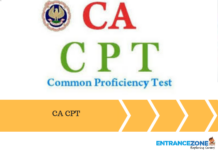|
Chapters
|
Topics
|
Marks
|
|
Solutions
|
- Types of solutions, expression of concentration of solutions of solids in liquids
- The solubility of gases in liquids solid solutions, colligative properties.
- Relative lowering of vapour pressure
- Raoult’s law, the elevation of boiling point, depression of freezing point, osmotic pressure
- Determination of molecular masses using colligative properties
- Abnormal colligative properties
|
23
|
|
Solid State
|
- Classification of solids based on different binding forces
- Amorphous and crystalline solids.
- Unit cell in two dimensional and three-dimensional lattices,
- calculation of density of unit cell
- Packing in solids, packing efficiency, voids
- Point defects, electrical and magnetic properties.
- Band theory of metals, conductors, semiconductors and insulators and n & p-type semiconductors.
|
|
Electrochemistry
|
- Redox reactions, electrolytes and non-electrolyte conductor, conductance in electrolytic solutions,
- Specific and molar conductivity, a variation of conductivity with concentration,
- Kohlrausch’s Law, electrolysis and laws of electrolysis
- Dry cell electrolytic cells and Galvanic cells, lead accumulator,
- EMF of a cell, standard electrode potential, Nernst equation and its application to chemical cells
|
|
Chemical Kinetics
|
- Rate of a reaction, factors affecting the rate of reaction,
- Rate law and specific rate constant
|
19
|
|
Surface Chemistry
|
- Adsorption – physisorption and chemisorption, factors affecting adsorption of gases on solids, catalysts.
- homogenous and heterogenous activity and selectivity.
- True solutions, colloids and suspensions.
- properties of colloids; Tyndall effect, Brownian movement, electrophoresis, coagulation.
- Emulsion- types of emulsions.
|
|
General Principles and Processes of Isolation of Elements
|
- Principles and methods of extraction.
- Concentration, oxidation, reduction.
- Electrolytic method and refining.
- Occurrence and principles of extraction of aluminium, copper, zinc and iron.
|
|
p – Block Elements
|
Group15, Group 17 and Group 18 Elements-
General introduction, electronic configuration, occurrence, properties, classification, preparation of different compounds and their use.
|
|
d and f Block Elements
|
General introduction, electronic configuration, occurrence and characteristics of transition metals,
General trends in properties of the first-row transition metals – metallic character, ionization enthalpy, oxidation states, ionic radii, colour, catalytic property, magnetic properties, interstitial compounds, alloy formation, preparation and properties of K2CrO7 and KMnO
|
|
Coordination Compounds
|
- Coordination compounds – Introduction, ligands, coordination number, colour, magnetic properties and shapes.
- IUPAC nomenclature of mononuclear coordination compounds.
- Bonding, Werner’s theory.
- VBT and CFT- structure and stereoisomerism.
- Importance of coordination compounds.
|
28
|
|
Haloalkanes and Haloarenes
|
Haloalkanes-
- Nomenclature, nature of C-X bond, physical and chemical properties, mechanism of substitution reactions, optical rotation.
- Haloarenes- Nature of C – X bond, substitution reactions.
- Uses and environmental effects of dichloromethane, trichloromethane, tetrachloromethane, iodoform, freons, DDT, BHC.
|
|
Alcohols, Phenols and Ethers
|
- Alcohols- Nomenclature, methods of preparation, physical and chemical properties, identification of primary, secondary and tertiary alcohols, mechanism of dehydration, uses with special reference to methanol and ethanol.
- Phenols- Nomenclature, methods of preparation, physical and chemical properties, acidic nature of phenol, electrophilic substitution reactions, uses of phenols.
- Either-Nomenclature, methods of preparation, physical and chemical properties uses
|
|
Aldehydes, Ketones and Carboxylic Acids
|
Each and every topic
|
|
Organic compounds containing Nitrogen
|
Nomenclature classification, structure, methods of preparation, physical and chemical properties, Uses, identification of primary, secondary and tertiary amines.
|
|
Polymers
|
- Classification- polymerization, co-polymerization, some important polymers- polythene, nylon, polyester, bakelite, rubber.
- Biodegradable and non-biodegradable polymers.
|
|
Chemistry in Everyday life
|
- Chemical in Medicines- Analgesics, tranquillizers antiseptics, disinfectants, antimicrobials, antifertility, drugs, antibiotics, antacids, antihistamines.
- Chemical in Food- Preservatives, artificial sweetening agents, elementary idea of antioxidants
- Cleansing agents-Soap and detergents, cleansing action.
|


















I need mpbse model paper of class 12th
Is it true in reduced syllabus 30per in this 2022 ur?????
What is syllabus year of this
Is it true??
I’m unable to get 2021 reduced Syabllus
Okay guys follow me on Instagram :thewanderquest_